Woodwind ligatures and caps might be small components, but they have a big effect on how you sound when playing a clarinet or saxophone.
The right ligature can make sure your reed stays snugly in place while you play, and can ensure you cleanly hit the high notes in your performance.
A great cap will protect your mouthpiece, ligature, and reed between practices and concerts, so that you can achieve the same moving sounds each time you pick up your instrument.
We checked out sets of woodwind ligatures and caps, and we found our top pick, available for most clarinets and saxophones.
There are other good ligatures and caps available for specific types of clarinets and saxophones as well, so read on to see how we rated these essential pieces of the woodwind experience.
Regardless of their sizes, you always want to buy the best components possible for your sax or clarinet. We developed our choice of the best woodwind ligatures and caps that you can currently buy on the market to help make your choices easier.
We put these reviews together using a combination of our own experiences and the input of other people familiar with woodwind instruments. We spent hours examining ligature and cap sets for different types of clarinets and saxophones to get a definitive list of what you can currently buy.
I applied my own standards for ligature and cap quality, as I played Bb clarinet for three years. To make sure I got input on ligatures and caps for other types of woodwinds, I talked to music store staff and musicians who play the bass clarinet, alto clarinet, and different kinds of saxophones.
I asked them what ligatures and caps they used, what they look for in these products, and which products they thought were the best.
Their assistance helped us build the list of the best woodwind ligatures and caps on the market, headed by the Vandoren LC01P Optimum.
My Recommendation: Vandoren LC01P
Offers high-quality control over your mouthpiece and reed, allowing you to play even the most extreme notes in your instrument's range while still sounding bright and clear.
We chose the Vandoren LC01P Optimum Ligature and Plastic Cap as the best woodwind cap and ligature set for a few reasons.
Price-wise, the LC01P Optimum is not the cheapest component set, but you can plan on it lasting for a long time, making it more of an investment in your music than a expense.
Along with the durability and the longevity of the ligature and cap, the Vandoren LC01P Optimum Ligature and Plastic Cap provides other desirable features with minimal drawbacks.

Credit: Amazon.com
It is available for any single-reed woodwind that requires a ligature. Even if you play a German clarinet or a soprano saxophone, Vandoren sells a form of the LC01P that will work for your instrument. The differences between the varieties might not seem extensive, but we can say that this ligature and cap pair will most likely suit your instrument, no matter what you play.
We could get the right tension, and therefore the right tone, without a great deal of screwing and unscrewing the ligature. Within moments, we were able to get a clear tone from our clarinet. Other musicians have praised the saxophone version of the LC01P for the same reason.
We found that we were able to get our high notes to sound bright with this ligature, without any squawking.
Professional musicians told us that they relied on the LC01P when playing jazz on the saxophone that required extensive switching between high and low notes, because they felt both would naturally come through properly with this ligature.
After capping the clarinet and letting it sit for a while, we were able to uncap it and get back to the right tension in no time, getting the same sounds on the clarinet as when we first slid the LC01P on. Other musicians have also commended the level of control the cap provides, without changing the tension.
This ligature makes use of pressure plates, and actually comes with different plates so that you can configure them with your reed to change your sound, if needed. This is great especially for seasoned musicians who may need to achieve different tones depending on the music they are playing.
Some alto saxophone and Bb clarinet players, though, have added that they had to align the reed and plates in a highly specific fashion, and that they could not get their instruments to sound quite right without spending time making these adjustments.
The materials are durable, and the metal ligature and plates are likely to last you a long time. The materials, coupled with the price, makes the LC01P a good instrument for experienced players, music students who are in college or high school, and musicians who will be touring.
One musician from a hot, humid climate did say, though, that the cap suffered environmental damage, although the climate did not affect the performance of the ligature in any way.
Runner Up: BG L4 R
The leather wraparound construction felt very flexible and forgiving when it came to getting the right tone.
Our runner up for cap and ligature combinations is the L4 R Ligature with Cap, made by BG. The L4 R Ligature is only made for the Bb clarinet, so not all woodwind players will be able to make use of it, but it is still a product set that has some exceptional qualities.
The first is the price because it is much more affordable than the LC01P.

Credit: Thomann GmbH
If you just picked up a clarinet you have not played in a long time, or want a backup ligature, this product will fit nicely inside your price range. This ligature and cap combination has other good aspects, as well.
We tried this ligature out on the Bb clarinet, and we were able to get a warm tone that we did not get with metal ligatures.
The leather wraparound construction felt very flexible and forgiving when it came to getting the right tone. Other musicians supported our observations, and said that they used the L4 R Ligature specifically for jazz performances and small ensembles where the warm sound could get through to the listeners.
The ligature’s construction felt solid for the materials that were used, although the cap seemed a bit weak to us.
A music store staff member told us that she usually advised people to buy a cheap, but thick, plastic cap or a metal cap in a larger size to protect the entire ligature, and not just the reed. She said the cap that comes with the L4 R Ligature cracks easily and fails to protect the most important part of the ligature, namely, the contact rails.
Leather products will not last forever, but she told us the L4 R Ligature was tough enough to endure frequent use for at least a few years. Eventually, though, she cautioned that the contact rail, which is a concave metal piece, could crack.
Also, a musician from a humid climate warned us that very humid climates could wear the leather down even faster.
Vandoren LC24P Leather
The reed vibrated easily and fully, and we heard a warm, mellow tone.
The LC24P Leather Ligature and Plastic Cap is another product by Vandoren that we considered. This product also has a leather ligature, and works with bass clarinets.
It is a pressure plate ligature, unlike our runner up.
While that price might seem a bit steep for a leather product, the leather construction is double-sided and stitched together, making it highly sturdy, and the cap is large enough to fully cover the ligature.
Musicians who have used the LC24P have told us that it does not wear down as quickly as other leather or fabric ligatures, that humidity does not change its tension quite as much as other leather ligatures, and, best of all, that they like the tone it gives.
When we tried it, we found it was easy to get the right tension, and we loved the sound that it offered. The reed vibrated easily and fully, and we heard a warm, mellow tone.
Even if this product wears more slowly than some of its competitors, it seems like a ligature and cap set that bass clarinet players might want to use occasionally, with another, sturdier ligature and harder cap to serve as the main set.
Musicians who own the LC24P say that is the way they use the set, especially if they are touring or constantly taking their clarinet to different places, like frequent practices or numerous concerts.
Glory Clarinet Mouthpiece Kit
Young musicians and beginners of all ages will still be able to hit all of the notes they will be playing.
The next set of woodwind ligatures and caps we checked out was the Glory Clarinet Mouthpiece Kit. This is a very inexpensive set for Bb clarinet players..
Even at this low price, the metal ligature seemed very sturdy, and the screws worked easily. While this ligature makes use of a pressure plate, the set only comes with a single plate, so you would definitely want to make sure you have an extra plate or two on hand, just in case.

Credit: SD Instruments
We thought the plate that comes with the set seemed sturdy enough, but musicians warned us that this plate is capable of cracking with frequent use, especially if you like to play with your ligature at a high tension.
The set comes with a mouthpiece, but several musicians have reported that, even though the low price and mouthpiece makes this a good product for beginning clarinet players, the mouthpiece does not seem to fit all clarinets.
You will want to check ahead of time to make sure the Glory mouthpiece works with your instrument. You might find that you need to get a separate mouthpiece with a smaller cork size, and just use the ligature and cap.
Professional musicians and highly experienced clarinetists will want to look elsewhere, because we noticed that the ligature prevented us from hitting extremely high notes when we tried it out.
Music store employees have told us this restriction is a common problem with the Glory set, so they do not advise seasoned clarinet players to use it, but they also told us that young musicians and beginners of all ages will still be able to hit all of the notes they will be playing.
Rico H-Ligature and Cap
Another possible option for beginning musicians who are playing the tenor saxophone is the Rico H-Ligature and Cap. You can find this set selling for $25 to $40, making it a solid, affordable buy.
This component set offers an impressive gold-plated ligature that contains an H-band, which saxophone players have told us can permit better control over tension and sound compared to ligatures that wrap around the mouthpiece completely.

Credit: Musician’s Friend
On the downside, though, the saxophone player we asked to try this set out found that positioning the H-band was difficult. When they had the bar of the H-band in the wrong place, we heard hissing, and some squeaking when the saxophone player blew in.
After several minutes of experimentation, the musician got the right spot, and the saxophone sounded clear and bright.
Experienced musicians have told us, though, that when they played their saxophone for roughly 30 to 60 minutes, the ligature would rotate around the mouthpiece, forcing them to stop and re-adjust the ligature.
The cap slid snugly over the mouthpiece and ligature, and seemed like it would give decent protection, although the plastic was a bit thin.
This could be a fine ligature and cap pair for a novice tenor sax player, but if you play your saxophone frequently and for extended periods of time, you should consider a different set of components.
Vandoren LC90P Optimum Gold Gilded Ligature and Cap
We researched another Vandoren woodwind component set, the LC90P Optimum Gold Gilded Ligature and Cap pair.
Like our pick for the best ligature and cap pair, the LC01P Optimum, the LC90P is available for all of the major types of clarinets and saxophones, so you can find this product for any of these woodwind instruments.
This component set is built to last. It includes a gold-plated pressure plate ligature, along with two additional pressure plates.
Each of the pressure plates has a different type of contact with the reed, including four individual raised bumps, and dual transverse contact rails, so you can use the plate that you prefer, or that delivers the right sound.
We thought this would be useful for versatile musicians who play multiple styles of music; you could play melodic classical music with one plate, then switch to a plate with less contact area in order to hit extremely high notes during a jazz solo.
The H-ligature does require some testing and adjustment to place it in the right position, but once you find that position, the ligature stays in place quite well. Music store employees told us the ligature is not prone to sliding, even after playing for an hour or more.
We could see this ligature being a good pick for clarinet and saxophone players who often play concerts or experienced amateur musicians who simply like to jam for hours on end.
Rovner C2R Mark III Ligature with Cap
Good product for long-time clarinet and saxophone players who play complex or extended pieces that use a lot of low notes.
Another ligature and cap set that made our shortlist for reliable components was the Rovner C2R Mark III Ligature with Cap.
Rovner makes ligature variations for this set that fit most saxophones and clarinets, but depending on the instrument, this set may have either gold or nickel fittings.

Credit: Musician’s Friend
We were told by musicians the fabric strap was sufficiently sturdy, although we think that people who live in humid climates may want to look out for tension changes and wear with the C2R Mark III.
Also, musicians said that this ligature works best if you have a mouthpiece made out of rubber, but we heard more mixed reviews about whether the C2R Mark III could potentially be used with plastic mouthpieces.
Some musicians said the ligature worked fine, others said that they could not get the right sound from it with a plastic mouthpiece.
Another cautionary note was that the ligature did not seem to fit larger mouthpieces, and that you might even need to fit the ligature upside down to put it in the right position to get the notes you want.
Musicians have told us this ligature is optimal when you want to play with a mellow, deep sound, full of robust low notes.
The cap may not fit all mouthpieces either, so you may find that you require a different cap even if the ligature works for you.
Overall, the Rovner C2R Mark III Ligature with Cap would be a good product for long-time clarinet and saxophone players who play complex or extended pieces that use a lot of low notes.
Using Woodwind Ligatures and Caps
Let’s talk a bit about what ligatures and caps do, because understanding their functions will help you select products that are right for you. The cap has as a straightforward purpose, as it slips over the mouthpiece, including the ligature and reed.
A sturdy cap protects the reed from breaking or cracking and helps keep your ligature at the desired tightness when you are not playing. Whether you keep your clarinet or sax at a practice space, or constantly transport it to school, practice, or concerts, you need a solid, resilient cap.
Whether you keep your clarinet or sax at a practice space, or constantly transport it to school, practice, or concerts, you need a solid, resilient cap.
Ligatures seem to play a simple role, because they hold the reed in place on the mouthpiece. However, selecting and using the right ligatures can be a trickier issue than many people initially think.
The Wikipedia article on ligatures states that ligatures, used only with single-reed woowinds, must perform two main functions. They hold the reed in place, as we have said, but they must also let the reed vibrate while it is held in place.
Ligatures permit the right amounts of vibrations when you blow upon the reed, because they absorb excess vibrations, yet they must also let the reed move enough to permit you to create large dynamic and tonal ranges.
The reed vibrations are fundamental to creating sound from woodwind instruments like clarinets and saxophones.
The ligature is essential for ensuring your woodwind sounds good. Even if you are a talented player, a weak ligature or one that is difficult to adjust correctly will make your performance weaker.
Sometimes even seasoned woodwind players do not put on their ligature in a way that promotes an optimal sound.
Both beginners and veterans who play clarinets, in particular, can benefit from watching this Youtube video by Anthony Mcgill, which offers an informative explanation about proper reed placement and fastening the literature.
From personal experience, I can say that learning how to properly place and adjust your ligature is one of the first things you should do after getting a clarinet.
Saxophone players have told us that the same concept holds true for their instrument of choice as well, no matter which type of saxophone you play.
Differentiating Quality Ligatures and Caps
When you are looking for the right ligatures and caps for your instrument, you will notice a few major differences between them.
Knowing these will help you select a ligature that will help your instrument play clearly and in tune, and a cap that will adequately protect your mouthpiece and reed.
Metal vs Plastics
The first difference you will notice with ligatures is that you can buy ligatures made from an astounding array of materials.
Some ligatures are crafted from softer materials like leather or naugahyde, and many inexpensive ones are plastic.
Metal ligatures are also frequently seen, and they use alloys that may be covered with nickel, or even precious metals like gold or silver.
Different materials can impact how your reed will sound, and of course, how much the ligature costs.
Construction
Ligatures also have structural differences. Certain ligatures make use of a pressure plate that the band touches, so that the band’s tension is changed using a thumbscrew and block design.
Others simply wrap around the mouthpiece and allow the band to directly touch the reed. These can also affect your sound, the ease of use, and whether you will need to have extra pressure plates on hand for plate ligatures.
Plates
If you happen to have a pressure plate ligature, you might also have seen that not all plates are designed in the same way.
Manufacturers and musicians have developed a range of plate shapes, some of them making use of creative innovations like small contact points that sit upon the reed.
Others have a curved shape that touches the reed on each end, allowing for more controlled contact, while still letting the reed vibrate correctly.
You may need to experiment with different plates, or consult a music teacher or experienced musician, to find out which plates would best meet your needs.
Contact Rails
The contact rails are comprised of different materials, and may not always be identical to the material that makes up the majority of the ligature. They are often metal, but some plastic rails, and even wooden rails can be found.
Certain rails are better at retaining the same tension without adjustment, but you should always check the ligature’s tension before playing to ensure that it is correct regardless of which materials your contact rails are made out of.
The contact rails may also have different configurations. Some sit across the reed, and others are aligned in the same direction.
Both configurations can keep reeds in place, but they can vary in their need to be adjusted. Personal preference can also influence which type a musician uses.
Caps tend to be made of plastic, but there are still some differences in the materials used to make them. Manufacturers produce both hard plastic caps and thinner, more flexible plastic caps.
These may offer different levels of protection for your instrument, but also differ in whether they change the ligature tension on the reed while the instrument is capped.
What Are the Advantages and Disadvantages?
Ligatures and caps both fill different essential roles for woodwind instrument players. These components deliver crucial advantages when you pick up a clarinet or sax.
Tone
The most important advantage for any musician is the tone of the instrument. When you find a ligature that works for you, you’ll hear your notes come out clearly, you can maximize the effective range of your instrument, and you’ll get the timbre that fits your style of play.
Non-musicians might wonder what is so exciting about a tiny component like the ligature, but musicians understand that finding the right ligature is worth time and experimentation.
Tightening
Some ligatures do not need to be tightened as often. Their structure and materials hold the reed in place at a consistent tension over time more effectively.
With these ligatures, you do not need to spend a large amount of time adjusting the ligature tension before you play.
Climate
Ligatures can vary in their performance depending on the climate. You might not want a highly elastic ligature that can also shrink, such as a leather ligature, if you are in a humid place, or one that is prone to rapid temperature changes.
In those climates, a plastic or metal ligature may keep you from having to readjust the tension of your ligature while playing.
Climate can also affect cap durability. Softer plastic caps, and any caps that contain synthetic rubber or padding, can shrink and crack, or even crumble away, in extremely humid places. Metal or hard plastic, on the other hand, will hold up quite well in these environments.
Elastic vs Hard
Elastic ligatures have advantages of their own, however. Musicians who use them can enjoy a significantly large spectrum of tension that will allow the instrument to sound great.
With sturdier ligatures that are relatively inelastic, the right tension may be a very specific point that you must experiment to find.
Hard caps that cover a larger area of the mouthpiece can protect the reeds and mouthpiece from accidental damage.
This benefit, of course, of one that touring musicians, or any musician who plans on taking their instrument to different places often, have to make use of. Even with a case, you need to make sure your reed stays safe.
If you mostly play your woodwind instrument in a single place, you might prefer a cap that fits slightly looser on your mouthpiece and is not rock-hard.
With these caps, you will have sufficient protection for your reed, yet you also will be able to easily and swiftly attain the right tension on the ligature when you play it.
Offers high-quality control over your mouthpiece and reed, allowing you to play even the most extreme notes in your instrument's range while still sounding bright and clear.
The leather wraparound construction felt very flexible and forgiving when it came to getting the right tone.
The reed vibrated easily and fully, and we heard a warm, mellow tone.
Young musicians and beginners of all ages will still be able to hit all of the notes they will be playing.
Good product for long-time clarinet and saxophone players who play complex or extended pieces that use a lot of low notes.

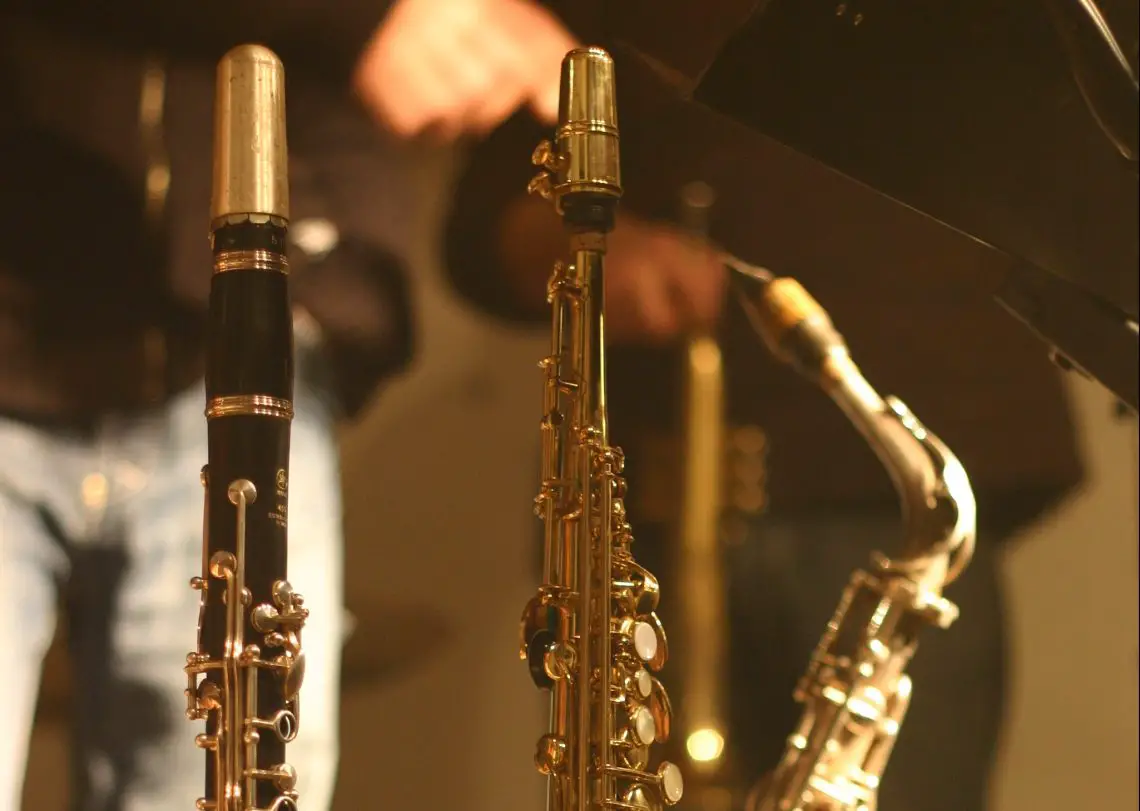









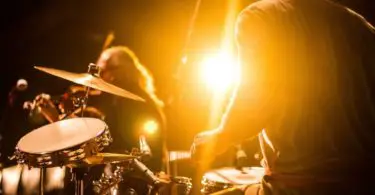

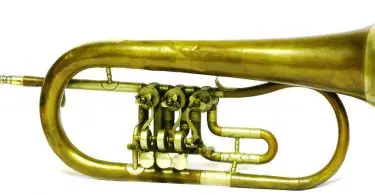
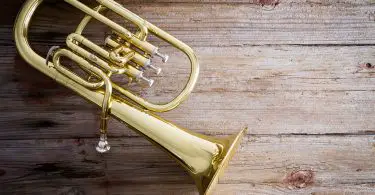
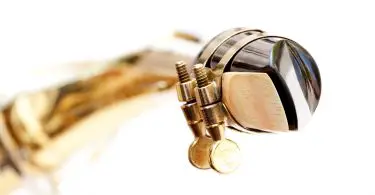

Hi,
Question I hope someone can answer: I have a vintage sax, with the original mouthpiece. I have been told time and again, nothing sounds quite as good as using the original mouthpiece, and that Im quite lucky it came with it. I did buy a newer one for daily use, but use the original when I really want the sound perfect. Problem, the ligature is quite old as well and Im doubtful it’s as tight as it should be. Is it best to use it as it? Or, mix a new ligature with the original mouthpiece?
Thanks!